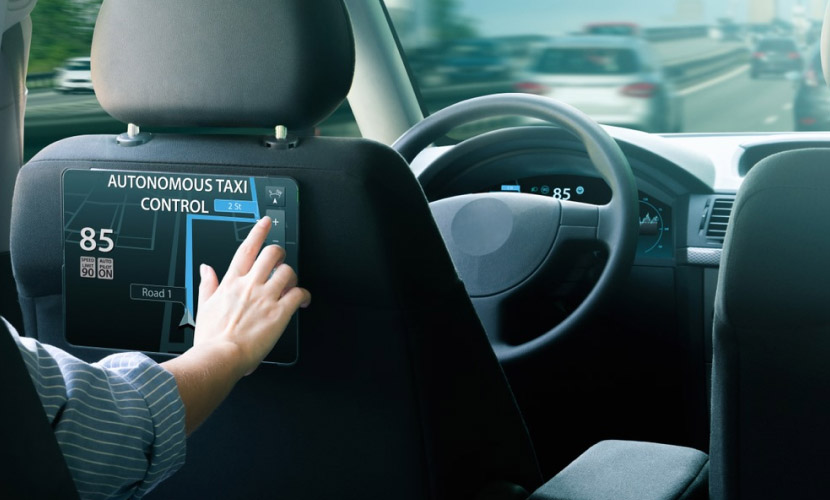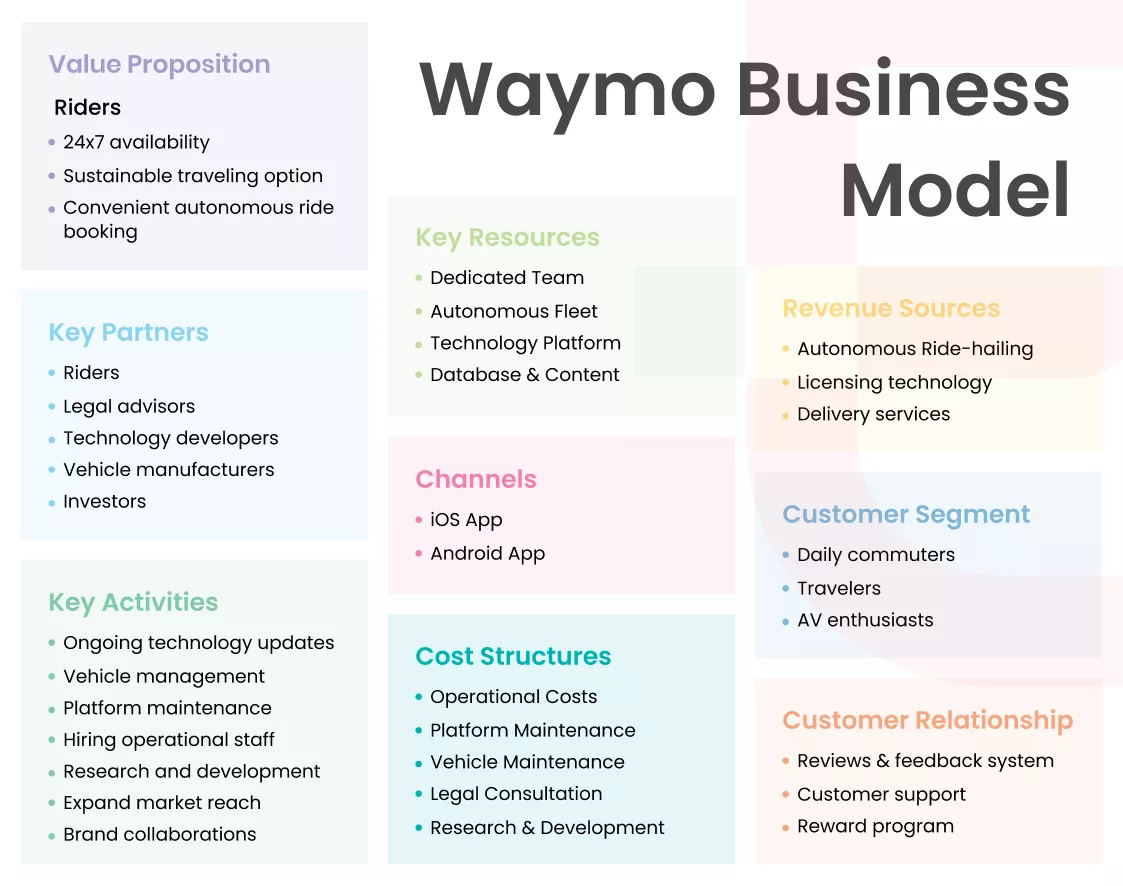
Waymo is one of the prominent autonomous car operators in the world. Developed by Google, this robotaxi service provider uses a proprietary system to offer exceptional driverless taxi services. While the company is famous for its autonomous technology, the Waymo business model is another significant aspect that truly sets it apart.
- Waymo History: How Waymo Found Its Way To Success
- Waymo’s Fundings & Market Coverage
- How Waymo Works: A Complete Workflow for Riding in Autonomous Taxis
- Waymo Business Model: Let’s Have Insights into Its Different Elements
- Waymo Revenue Model: Exploring Waymo’s Income Generation Strategy
- Key Competitors of Waymo in the Autonomous Car Industry
- How Does Waymo’s Cutting-Edge Technology Work?
- The Takeaway
Powered by its unique business model, the company has been soaring in the USA robotaxi industry, inspiring many entrepreneurs to follow in its footsteps and establish similar taxi booking services. If you’re looking for the same, you’re in the right place.
Keep reading the article to explore Waymo’s winning business strategies, revenue streams, and workflow, as well as its key rivals already existing in the market. Ultimately, after reading this blog, you will have a sound understanding of its overall business, allowing you to be well-prepared for starting a ride-hailing business based on AI.
Waymo History: How Waymo Found Its Way To Success
Initially, Waymo was Google’s self-driving project, which was started at its Moonshot Lab in 2009. A year later, Google prepared its first model to start testing autonomous cars.
The testing went on for a few years, gathering about 300,000 miles of travel data. Such massive data collection represents a remarkable milestone in self-driving technology, opening tons of possibilities for autonomous vehicle (AV) research worldwide.
After some more testing and algorithm tweaking, Google launched its first self-driving car prototype in 2014. Two years later, in 2016, Google decided to commercialize this project, leading it to launch Waymo—its autonomous vehicle technology company.
In the same year, it was separated from Google and established as a subsidiary of Alphabet Inc. (Google’s parent firm).
With this new identity, this AV company was all set to grow its operations and resources to speed up its development.
After ample testing and collecting millions of miles of data, in 2017, it started its autonomous ride-hailing service, Waymo One, in Phoenix, Arizona. This was the first time the public could travel in a completely driverless taxi.
However, its driverless cars weren’t prepared for long-distance traveling yet. They were geofenced and could only travel within a 100-mile area. Moreover, it also had some reliability issues among customers. They were not aware of these self-driving vehicles’ actual functions, hence they couldn’t rely on them.
The company launched its Early Rider program to encourage customers, in which robotaxi enthusiasts were invited to experience fully automated vehicles. The objective was to showcase the robotaxi’s reliability in real-life situations and build people’s trust.
The well-tested vehicles showcased their safety and efficiency on the roads, paving the way for the company to launch its full-fledged driverless ride-hailing services across the Phoenix metropolitan area.
Waymo’s Fundings & Market Coverage
All these efforts wouldn’t have been possible without adequate financial aid. Any digital startup that wants to scale needs to acquire funds through either of the prevalent funding options at some point in its journey. And Waymo wasn’t an exception.
To support its operations, Waymo raised several funding rounds, with the most recent being a $5.6 billion funding round in October 2024. With this financial aid, the robotaxi firm has massively boosted its operations across various cities in the USA.
Currently, it has a presence in Phoenix, San Francisco, Los Angeles, Austin, Georgia, and Atlanta, where they have launched a driverless ride-hailing service in partnership with Uber, allowing users to request Waymo vehicles through this popular ride-hailing platform. For the time being, the service operates within a 65-square-mile area of Atlanta, with plans to expand in the future.
This robotaxi firm has come a long way since it was launched in Phoenix, evolving into the top driverless taxi service provider in the USA market. Overall, it has crafted an exceptional autonomous vehicle that offers its customers smoother and more reliable rides.
Moreover, its intuitive app interfaces make ride-booking even more seamless. Anyone registered with the app can easily call an autonomous taxi with just a few taps. Let’s take a look at how Waymo works, allowing its customers to hail a ride in a faster and more delightful way.
How Waymo Works: A Complete Workflow for Riding in Autonomous Taxis
This autonomous taxi-booking firm has a dedicated app for Android and iOS users. Although its ride-hailing services are offered only in the USA, the app is available to download in the following countries:
- Canada
- India
- Japan
- Singapore
- Mexico
- Great Britain (UK)
- Australia
- New Zealand
Now, let’s have a quick look at how Waymo works, allowing its riders to get a seamless traveling experience in driverless cars.
Step 1: Calling For The Ride
- After downloading the Waymo app, the customer has to enter their destination location.
- The app will automatically select the safest spot to pick them up and drop them off.
- Once the customer books a ride, they can track their autonomous taxi with an estimated time of arrival, which keeps updating in real-time.
- While the car’s on the way, the customer can change their pickup or drop-off locations by adjusting the location pin.
Step 2: Getting Into the Car
- The robotaxi will pull over at the closest safe and convenient place. The customer might need to walk a few steps to reach it.
- When the customer gets to their car, they can lock or unlock it with their app.
- If they have cargo like luggage or groceries, they can use the trunk to load it.
- Once done, they can hop in their robotaxi to start the ride.
Step 3: Starting The Ride
- Once the customer gets in and straps the belt, they can start their ride by tapping the Start Ride button in their app or directly from the screen attached in the car.
- This digital screen displays the path and other information about the ride.
Step 4: Finishing The Ride
- If the customer needs to pause or end the trip early, they can tap the Pull Over button on the screen.
- Customers can leave real-time feedback about the robotaxi’s driving behavior, allowing the company to identify any areas that need improvement.
- At the end of the ride, the screen will remind the customer to take their essential items and let them know if a car or bicycle is coming their way before they open the door.
So, here’s how the company takes care of its riders, giving them an exceptional autonomous ride-hailing experience.
Waymo Business Model: Let’s Have Insights into Its Different Elements
The company uses its proprietary technology to offer driverless cab services. The mix of high-end systems and a robust business model is the major reason behind its success in the robotaxi market.
Below, we have broken down the Waymo business model in a clear canvas to help you understand how each segment works cohesively.

Let’s take a closer look at this unique business model of Waymo.
Key Partners
- Riders: End users who use robotaxis to travel around.
- Legal advisors: Attorneys and legal consultants who offer their consultation services on legal matters and help the company create policies that comply with regulations.
- Technology developers: Programmers who build AI algorithms and IoT devices for the company’s autonomous cars.
- Vehicle manufacturers: Automobile manufacturers that provide their vehicles to the company for their driverless ride-hailing services.
- Investors: Investors who provide funds to meet the financial requirements for the company’s growth.
Value Proposition
Value Proposition for Riders
- Riders can book a ride whenever they want with the 24×7 availability of driverless ride-hailing services.
- They can quickly book a robotaxi through a dedicated app that offers a smooth user experience.
- By opting for a sustainable travel option with a driverless electric vehicle, they also contribute to environmental well-being.
Key Activities
- To remain competitive in the autonomous ride-hailing market, the company needs constant updates to its proprietary technology.
- It also conducts regular vehicle maintenance to ensure that they run smoothly.
- To be able to offer a smoother booking experience, the company strives to keep its application performant.
- The autonomous ride-hailing company also recruits, trains, and manages operational staff to handle its various business functions.
- As part of the larger autonomous vehicle development project, the company also manages financial resources for research and development.
- It seeks opportunities to expand Waymo’s market reach.
- Lastly, it also collaborates with other brands to explore different business avenues.
Customer Segment
- The platform caters to daily commuters who travel to and from their workplaces or educational institutions.
- It also serves travelers visiting cities where they provide their services and want a trustworthy ride-hailing service.
- Autonomous vehicle enthusiasts who love exploring in driverless cars also become Waymo’s customers.
Customer Relationship
- The company employs a seamless review and rating system to gather customer feedback.
- Its comprehensive customer support offers quick services, allowing its customers to get instant assistance before, during, or after the ride.
- It offers a lucrative reward program where customers can enjoy autonomous ride-hailing services at discounted rates.
Deploy a Future-Ready Platform for Your Autonomous Ride-Hailing Business. Talk to Our Experts to Learn More and Get a Personalized Quote.
Waymo Revenue Model: Exploring Waymo’s Income Generation Strategy
The Waymo revenue model incorporates various income streams. These streams allow the company to generate a steady cash flow that sustains and grows its business. In this section, we will discuss how the company earns money through multiple revenue streams.
Ride-hailing
Fully autonomous ride-hailing services are the main source of income for the company. It employs its technology-featured vehicles and robust mobile app to offer driverless taxi services. It currently operates within the United States, mainly in cities like Phoenix, San Francisco, Los Angeles, and Austin.
Subscription
Subscription is one of the popular monetization models, and Waymo knows how to use it well for profit. It offers a special membership program to Waymo Teen Accounts, which is designed for teenagers aged 14-17 to hail robotaxi rides under parental guidance.
Licensing Technology
The company also earns an impressive income by licensing its proprietary technology to other companies. It offers its technology to online taxi-booking firms that want to start their driverless ride-hailing services. The licensing includes its sensors and autonomous driving system, designed to deliver an exceptional experience to riders.
Delivery Services
It also offers food delivery services by partnering with brands like Uber Eats. Although this service is limited to a specific part of the Phoenix Metropolitan area (as of early 2025), it has opened up another revenue stream that the company could scale over time.
Key Competitors of Waymo in the Autonomous Car Industry
The company is praised as being one of the first contenders in the robotaxi industry. The advantage of Google’s expertise and resources has made it possible to excel in a brief span of time. With further technological advancements in AI and ML, it has become stronger in its autonomous ride-hailing business.
This advancement also gave rise to the robotaxi industry, which is expected to grow to $118.61 billion by 2031, making it one of the fastest-growing sectors. This Google-owned robotaxi firm has been one of the earliest contributors to this industry.
But it’s essential to note that it isn’t the only one in the game. There are multiple market players offering their fair share in the industry growth. These emerging autonomous ride-hailing companies are putting up a tough fight against Waymo in this sector.
Let’s learn more about who these competitors are.
Tesla
Tesla has always been a close opponent of Waymo. It has recently built its autonomous robotaxi and is ready to launch its first fleet in Austin. Tesla is known for its rapid innovation, while Waymo boasts years of experience, making both of them major competitors in the AV industry.
Aurora
Aurora is another self-driving car company led by Chris Urmson. It has proprietary technology called Aurora Driver, which is designed for cabs and trucks. Currently, it’s working in San Francisco and other cities, giving tough competition to this self-driving ride-hailing company.
Wayve
Wayve is a UK-based autonomous ride-hailing startup preparing for global expansion. The company has already established a presence in Germany. While Waymo navigates the USA market, Wayve is constantly looking to expand in Europe. This puts Wayve in a more advantageous position, making it one of the prominent rivals for Waymo.
Pony.ai
Pony.ai is one of the greatest Chinese robotaxi companies currently operating in China. While it has not yet started serving overseas, its expansion in its native country is way more rapid than Waymo’s in the USA, making it one of the fastest-growing driverless taxi firms that could soon compete neck-and-neck with Waymo.
How Does Waymo’s Cutting-Edge Technology Work?
The adoption of AI mobility in the ride-hailing sector is on the rise, and Waymo has provided a significant boost with its advanced technology. But ever wondered how it works internally? If we look closely, Waymo’s autonomous technology consists of a sophisticated system of sensors, AI algorithms, and high-definition maps.
All these work in conjunction to create the most advanced, secure, and powerful ride-hailing service. Below, we will explain how these technologies work to provide the most comfortable and reliable services to their riders.
Sensors
Waymo uses LiDAR, radar, and cameras that keep watch on the vehicle’s surrounding area. The sensors continuously collect live data and send it for further analysis, allowing the system to make quick decisions.
AI Algorithms
AI algorithms analyze the collected information and predict the behavior of vehicles, people, and other road obstacles. These algorithms help make informed judgments and improve the vehicle’s driving capabilities over time.
High-Definition Maps
The high-definition maps offer information about road conditions, traffic patterns, and other obstacles that might affect the ride experience. Based on this map data, this AV system can make quick decisions like taking another route to avoid traffic and reach the destination in a short time.
The Takeaway
Waymo is one of the leading companies in autonomous ride-hailing, boasting the title of being the first company to offer driverless robotaxi services to the public. Its success resulted from years of research and its unique Waymo business model, which has allowed the company to swiftly adapt to changing customer demands.
At the core of this model lies the potential of AI. By looking at AI’s rapid expansion, it’s safe to say that driverless ride-hailing services will prevail in the near future. Hence, building an autonomous taxi-booking app with a reliable software development company can be a profitable venture in this age of AI.











